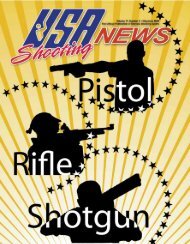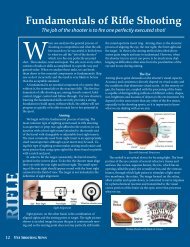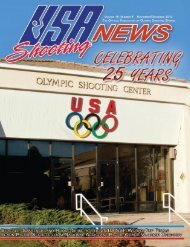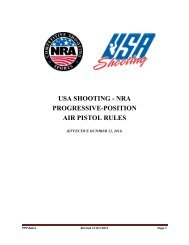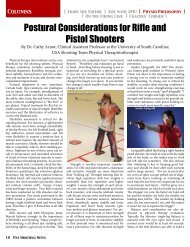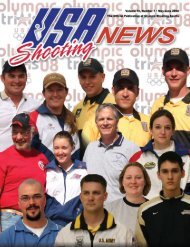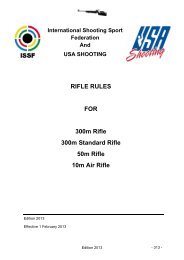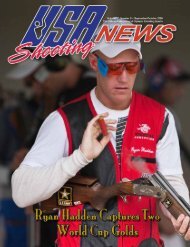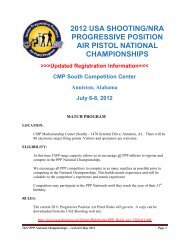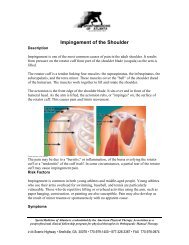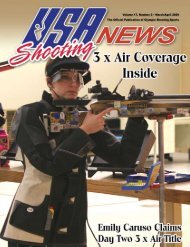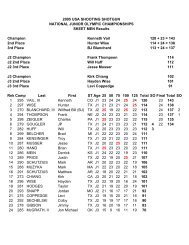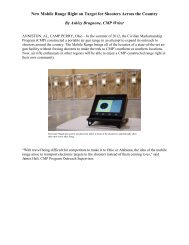January/February 2011: Volume 19, Number 1 - USA Shooting
January/February 2011: Volume 19, Number 1 - USA Shooting
January/February 2011: Volume 19, Number 1 - USA Shooting
Create successful ePaper yourself
Turn your PDF publications into a flip-book with our unique Google optimized e-Paper software.
From the competitions director<br />
New <strong>USA</strong>S & ISSF Rules Update<br />
<strong>USA</strong> <strong>Shooting</strong> has revised the<br />
<strong>USA</strong> <strong>Shooting</strong> Rules for the<br />
<strong>2011</strong> competition season.<br />
All new rules will be<br />
integrated into the current<br />
rule book and will be highlighted as ‘NEW”<br />
in the left hand column for <strong>2011</strong> edition.<br />
Here is an overview of the changes:<br />
<strong>USA</strong> <strong>Shooting</strong> will adjust the senior<br />
age group categories starting Jan. 1,<br />
<strong>2011</strong>. Senior age groups will be reduced<br />
from three to two and the starting age<br />
will increase to align with other<br />
organizations. An Intermediate Senior<br />
will be aged 55-64 and a Veteran Senior<br />
will be aged 65 and up. All current<br />
senior records will be retired.<br />
<strong>USA</strong> <strong>Shooting</strong> will also adopt the<br />
Orion system for air and smallbore rifle<br />
and provisionally for air pistol. The<br />
Orion system requires specific targets<br />
and scanner, but is becoming a popular<br />
scoring system. Matches shot using the<br />
Orion system will treated as electronic<br />
targets for scoring and protests.<br />
For more information about<br />
this product, please visit www.<br />
orionscoringsystem.com. Please watch<br />
the <strong>USA</strong> <strong>Shooting</strong> website for further<br />
information regarding this new targeting<br />
system and the introduction of the air pistol<br />
for the Orion System (expected mid-year).<br />
The ISSF has also made amendments<br />
to their rules regarding finals procedures, as<br />
well as a new format for Rapid Fire finals.<br />
Here is a summary of these rules, courtesy<br />
of the ISSF:<br />
ORDER FOR PREPARATION,<br />
TEST SHOTS AND ATHLETE<br />
PRESENTATION FOR SHOTGUN<br />
The order of presentation for shotgun<br />
has been changed so that finalists will now<br />
report 20 minutes before the start time.<br />
They will immediately be instructed to<br />
complete their warm-up and dry firing<br />
and fire test shots. Targets will also be<br />
shown before the presentation of finalists,<br />
which will occur four minutes before<br />
the start time. Immediately after the<br />
presentation of finalists, the athletes will<br />
go to their shooting stations and begin the<br />
final round competition. This change for the<br />
Shotgun presentation was already successfully<br />
implemented during the 2010 World<br />
Championship in Munich and the 2010 World<br />
Cup Final in Izmir, Turkey. The 20 second<br />
scoreboard pause in Trap and Double Trap that<br />
has taken place after five shooters have fired will<br />
now take place after each of the six finalists have<br />
fired the same number of targets. Tie-breaking<br />
shoot-offs will only be conducted on the finals<br />
field for first, second and third places.<br />
The new rules are desgined to help make the shooting sports more<br />
“television-friendly” for a wider audience of viewers.<br />
ORDER FOR PREPARATION, SIGHTING<br />
SHOTS AND ATHLETE PRESENTATION<br />
FOR RIFLE AND PISTOL<br />
Previous ISSF Rules called for the<br />
presentation (introduction) of finalists BEFORE<br />
the preparation period, sighting shots and<br />
the pause to reset the targets for the first<br />
record shot. This created a big problem for<br />
television because they want to cover the athlete<br />
presentations, but they are not interested in<br />
the 8 ½ minutes of warm-up activities between<br />
the presentations and first record shot. After<br />
analyzing this problem, we decided to reverse<br />
the final round procedure so that athlete<br />
presentations will now take place AFTER<br />
the warm-up activities. The new rifle-pistol<br />
presentation order is shown in Table 1.<br />
The announcement of scores after each<br />
final round shot will be followed by a short<br />
commentary about the current rankings.<br />
Television needs a delay of approximately 30<br />
seconds after each shot to be able to show the<br />
scoreboard and current rankings.<br />
A ranking monitor will be<br />
placed in front of each finalist so<br />
that all shooters will know their<br />
current rankings even if they do<br />
not understand the language of the<br />
commentator. After the Finals, tiebreaking<br />
shoot-offs will be conducted<br />
only for the first, second and third<br />
places. Other ties will be broken by<br />
the final round score and then by the<br />
Qualification ranking.<br />
RAPID-FIRE PISTOL FINALS<br />
FORMAT<br />
The new Rapid-Fire Pistol<br />
Final is much faster moving, easier<br />
for spectators to understand and<br />
offers many moments of action and<br />
drama throughout the final. Here<br />
is a summary of the new rapid-fire<br />
final (complete details are in the<br />
rules):<br />
1. Three 5-target units are used. Six<br />
finalists are assigned to the targets<br />
with two finalists on each 5-target<br />
group. There will be a 1.5m space<br />
between the two finalists’ firing points<br />
on each 5-target group.<br />
2. Six competitors will advance from<br />
the Qualification to the Final.<br />
3. All competitors will start at zero<br />
(0) in the Final. Note: the final is<br />
designed so that to win a gold medal<br />
a competitor must fire eight 4-second<br />
series; that is two times more 4-second<br />
series than competitors fire in the<br />
Qualification round.<br />
4. Hits are scored on the basis of hits<br />
and misses (similar to biathlon, easy<br />
for spectators to understand). The hit<br />
zone encompasses shots scoring 9.7 or<br />
higher.<br />
5. The preparation period and sighting<br />
series are completed before the<br />
presentation of finalists.<br />
www.usashooting.org 25<br />
jan feb <strong>2011</strong>.indd 25<br />
1/3/<strong>2011</strong> 10:46:20 AM



